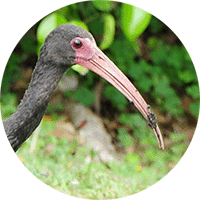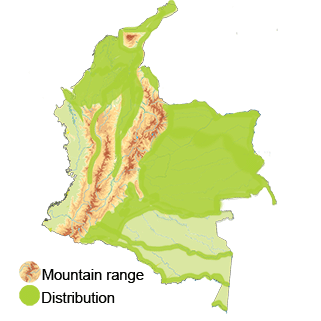Bare-faced Ibis
The Bare-faced Ibis (Phimosus infuscatus)
Appearance: The Bare-faced Ibis is a medium-sized bird with a distinctive appearance. It has a mostly dark plumage with a glossy greenish and purple sheen. One of its most notable features is its bare, reddish face and throat, which contrast with its dark plumage. The bill is long and downward-curved, and the legs are long and grey.
Habitat: The Bare-faced Ibis can be found in a variety of wetland habitats, including marshes, swamps, flooded grasslands, and rice fields. It is often seen foraging for food in shallow water or wet mud flats.
Behavior: Bare-faced Ibises are typically social birds and may be found in small groups or larger flocks. They feed on insects, small invertebrates, amphibians, and other small prey that they find in wetland areas. Their feeding behavior often involves probing their long bills into the water or mud to locate food.
Breeding: During the breeding season, Bare-faced Ibises may form breeding colonies in suitable wetland habitats. They build nests in trees or shrubs near water, where they lay their eggs and raise their young. Breeding pairs may engage in displays and vocalizations to establish pair bonds and defend their nesting territories.
Conservation Status: The conservation status of the Bare-faced Ibis in Colombia is currently categorized as "Least Concern" by the International Union for Conservation of Nature (IUCN).
Distribution
The Bare-faced Ibis (Phimosus infuscatus)
Northern Andes Region: The Bare-faced Ibis can be found in the northern Andes region of Colombia, including areas in departments such as Antioquia, Santander, and Norte de Santander.
Magdalena Valley Region: This species is also found in the Magdalena Valley region of Colombia, which includes parts of departments like Bolívar, Cesar, and Magdalena.
Llanos Region: The Bare-faced Ibis inhabits the extensive wetlands of the Llanos region in eastern Colombia, including areas in departments such as Meta, Casanare, and Vichada.
Amazon Region: Parts of the Amazon region in southern Colombia, including areas in departments like Putumayo and Caquetá, also provide suitable habitat for the Bare-faced Ibis.
Taxonomy
The Bare-faced Ibis (Phimosus infuscatus)
- Kingdom: Animalia
- Phylum: Chordata
- Class: Aves (Birds)
- Order: Caprimulgiformes
- Family: Threskiornithidae
- Genus: Phimosus
- Species: Phimosus infuscatus
Vocalization
The Bare-faced Ibis (Phimosus infuscatus)
- Grunt Calls: Bare-faced Ibises often emit low, guttural grunt calls that serve as contact calls between individuals in a flock. These calls help ibises stay in communication with each other while foraging or moving within their habitat.
- Croaking Calls: Another common vocalization of the Bare-faced Ibis is a croaking sound, which can vary in pitch and intensity. Croaking calls are often used in territorial displays or to assert dominance within the flock.
Whispering Calls: As their nickname suggests, Bare-faced Ibises are also known for producing soft, whispering vocalizations that can sound like a soft hiss. These calls are often used during courtship displays or in interactions between breeding pairs. - Alarm Calls: When threatened or disturbed, Bare-faced Ibises may emit loud, harsh alarm calls to alert other members of the flock to potential danger. These calls are typically sharp and repetitive, signaling the need for heightened vigilance.
- Flight Calls: While in flight, Bare-faced Ibises may produce distinctive calls that can help maintain flock cohesion and coordination. These flight calls may vary in intensity and pitch depending on the context of the flight.





